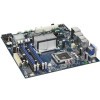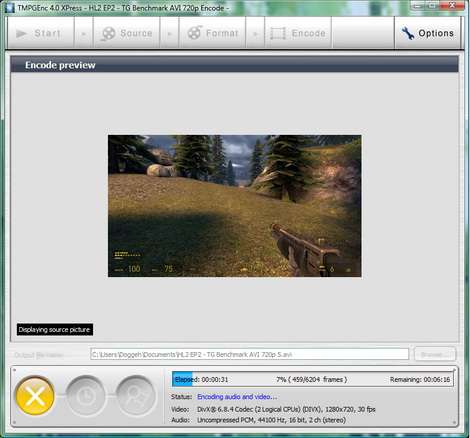- Qualcomm Launches Snapdragon 4 Gen 2 Mobile Platform
- AMD Launches Ryzen PRO 7000 Series Mobile & Desktop Platform
- Intel Launches Sleek Single-Slot Arc Pro A60 Workstation Graphics Card
- NVIDIA Announces Latest Ada Lovelace Additions: GeForce RTX 4060 Ti & RTX 4060
- Maxon Redshift With AMD Radeon GPU Rendering Support Now Available
Intel Desktop Board DG45ID

We’re taking a look at Intel’s first attempt at a full-featured media center motherboard, the DG45ID. It’s also our first look at their new G45 Express chipset, which promises to finally bring DX 10 support and hardware-accelerated HD video playback to their integrated graphics offerings. Can the DG45ID prove itself a worthy choice for your HTPC?
Page 6 – Multi-Media: DivX, Adobe Lightroom & 3ds Max 9
For our video conversion test, we use Pegasys TMPGEnc 4.0 Xpress to transcode (converting from one codec to another) a 0.99GB high-quality DivX H.264 AVI video of Half-Life 2: Episode Two gameplay with stereo audio. The video is just under 4 minutes in length and has a 720p resolution (1280×720).
For our testing, we encode the video at the same 720p resolution but with a lower quality, to achieve a more acceptable file size for distribution (~150MB). In all our transcoding tests, “Enhanced multithreading” is enabled in the codec control panel, as well as “Experimental full search” using the highest version of the SSE instruction set that the CPU supports.

In this test, the ASUS board beats the Intel board by several seconds. In our past experience, when it comes to CPU-Memory bandwidth, Intel boards tend to not be as highly-tweaked as their third-party counterparts. That’s likely the cause for the performance lag observed here.
Adobe Lightroom 1.4
Photo manipulation benchmarks are more relevant than ever, given the proliferation of high-end digital photography hardware. For this benchmark, we test the system’s handling of RAW photo data using Adobe Lightroom, an excellent RAW photo editor and organizer that’s easy to use and looks fantastic.
For our testing, we take 100 RAW files (in Nikon’s .NEF file format) which have a 10-megapixel resolution, and export them as JPEG files in 1000×669 resolution, like most of the photos we use here on the website. Such a result could also be easily distributed online or saved as a low-resolution backup. This test involves not only scaling of the image itself, but encoding in a different image format entirely. The test is timed indirectly using a stopwatch, and times are accurate to within +/- 0.25 seconds.

Again, while not by a huge margin, the Intel DG45ID still suffers a several-second performance hit in this memory-bandwidth-intensive and storage-intensive test. The conventional wisdom that Intel motherboards tend to place stability over performance holds true here as well.
Autodesk 3ds Max 9
Autodesk’s 3ds Max 9 is considered the industry standard when it comes to 3D modeling and animation, counting DreamWorks, BioWare, and Blizzard Entertainment among its users. It’s a multithreaded application that’s designed to be right at home on multi-CPU workstations or render farms, so it’s right up our alley for testing systems with multi-core processors. Its scanline renderer divides up the rendering task equally among the CPU’s cores.
In our testing, we use a standard dragon model provided with 3ds Max, ‘Dragon_Character_Rig.max’. The scene is rendered in two formats. First, a single frame from the animation is rendered at a resolution of 1920×1080 (1080p). Then, a 60-frame sequence of the same model is rendered to a 490×270 resolution AVI file, which can be exported to a portable media player.

Here, the Intel DG45ID again stays right at the ASUS motherboard’s heels, but can’t outpace the P5E-VM HDMI. 3ds Max tends to be more CPU-bound than most of our multimedia tests, but memory bandwidth also plays a part. Since no output file is specified in our testing, the loading of the storage subsystem during the test is slight.
Next, we’ll take a look at two more multimedia applications – audio encoding and blu-ray playback.
Support our efforts! With ad revenue at an all-time low for written websites, we're relying more than ever on reader support to help us continue putting so much effort into this type of content. You can support us by becoming a Patron, or by using our Amazon shopping affiliate links listed through our articles. Thanks for your support!







